- HOME
- Enzyme List
- PSP-101 PROLINE SPECIFIC ENDOPEPTIDASE
PSP-101
PROLINE SPECIFIC ENDOPEPTIDASE from Flavobacterium sp.

PREPARATION and SPECIFICATION
| Appearance | White amorphous powder, lyophilized | |
|---|---|---|
| Activity | Grade I 5.0 U/mg-solid or more | |
| Contaminants | Leucine aminopeptidase | ≤ 1.0×10-1 % |
| Trypsin-like activity | ≤ 1.0×10-1 % | |
PROPERTIES
| Stability | Stable at −20 ℃ for at least one year (Fig.1) |
|---|---|
| Molecular weight | approx. 78,000 |
| Isoelectric point | 9.1 |
| Michaelis constants | 2.5×10-5 M (Z-Gly-Pro-MCA) |
| 1.4×10-4 M (Z-Gly-Pro-2NNap) | |
| Structure | Monomer |
| Inhibitors | DFP, 3, 4-dichloroisocoumarin, Z-Gly-Pro-CH2Cl |
| Optimum pH | 6.5 (Fig.2) |
| Optimum temperature | 37 ℃ (40 ℃) 2) (Fig.3) |
| pH Stability | 5.5−8.5 (30 ℃,15 hr)(Fig.4) |
| Thermal stability | below 40 ℃ (pH 7.0,10 min) (Fig.5) |
| Substrate specificity | Y-Pro(Ala)-X (Y, peptide or N-protected amino acid; X, amino acid, peptide, amide, or ester)(Table 1) |
| Effect of various chemicals | (Table 2) |
APPLICATIONS
This enzyme is useful for determining the amino acid sequences of peptides and proteins containing proline residues.
ASSAY
Principle

The formation of p-nitroaniline is measured at 410 nm by spectrophotometry.
Unit definition
One unit causes the formation of one micromole of p-nitroaniline per minute under the conditions detailed below.
Method
Reagents
| A. K-Phosphate buffer, pH 7.0 | 0.1 M |
|---|---|
| B. Z-Gly-Pro-pNA solution | 5 mM[Dissolve 21.3 mg of Z-Gly-Pro-pNA(MW=426.43) in ca.8 mL of 40 % dioxane in a hot bath at 60 ℃, then cool down to 25 ℃, fill up to 10 mL with 40 % dioxane](Should be prepared fresh) |
| C. Acetate buffer, pH 4.0 | 1 M solution containing 10 % of TritonX-100 (Store at 5 ℃) |
| D. Enzyme diluent | 50 mM K-phosphate buffer, pH 7.0 |
Procedure
1.Prepare the following reaction mixture in a test tube, and equilibrate at 30 ℃ for approximately 5 minutes.
| 1.0 mL | Potassium phosphate buffer | (A) |
|---|---|---|
| 0.25 mL | Substrate solution | (B) |
| Concentration in assay mixture | |
|---|---|
| Phosphate buffer | 77.8 mM |
| Z-Gly-Pro-pNA | 0.926 mM |
2.Add 0.1 mL of enzyme solution* and mix by gentle inversion.
3.After exactly 5 minutes at 30 ℃, add 2.0 mL of acetate buffer (C) to stop the reaction, and measure the optical density at 410 nm against water (OD test).
At the same time, prepare the blank by first mixing the reaction mixture with 2.0 mL of acetate buffer (C) , after incubation for 5 minutes, at 30 ℃, followed by the addition of the enzyme solution (OD blank).
*Immediately before the assay, dissolve the enzyme preparation in ice-cold enzyme diluent (D) and dilute to 0.05−0.2 U/mL with the same buffer.
Calculation
Activity can be calculated by using the following formula :
Volume activity (U/mL) =
-
ΔOD (OD test−OD blank)×Vt×df
5.57×1.0×t×Vs
= ΔOD×1.20×df
Weight activity (U/mg) = (U/mL)×1/C
| Vt | : Total volume (3.35 mL) |
| Vs | : Sample volume (0.1 mL) |
| 5.57 | : Millimolar extinction coefficient of p-nitroaniline under the assay condition (cm2/micromole) |
| 1.0 | : Light path length (cm) |
| t | : Reaction time (5 minutes) |
| df | : Dilution factor |
| C | : Enzyme concentration in dissolution (c mg/mL) |
REFERENCES
1)T.Yoshimoto and D.Tsuru; Agric.Biol.Chem., 42, 2417 (1978)
2)T.Yoshimoto, R.Walter and D.Tsuru; J.Biol.Chem., 255, 4786(1980)
3)R.Walter; Biochim.Biophys.Acta.,422, 132 (1976)
4)T.Yoshimoto, R.C.Olowski and R.Walter; Biochem.J., 16, 2942 (1977)
5)T.Yoshimoto, M.Fischl, R.C.Olowski and R.Walter; J.Biol.Chem., 253, 3708 (1978)
6)T.Yoshimoto and D.Tsuru; Protein,Nucleic acid and Enzyme (Japanese), 29, 127 (1984)
7)L.Haeffiner-Gormley, L.Parente and D.B.Wetlaufer; Int.J.Peptide Protein Res., 26, 83 (1985)
8)T.Yoshimoto, K.Kawahara, F.Matsubara, K.Kado and D.Tsuru; J.Biochem., 98, 975 (1985)
Table 1. Substrate Specificity of Proline specific endopeptidase
| Substrate | Km (mM) |
kcat (s-1) |
kcat/Km (mM-1・S-1) |
|---|---|---|---|
| ↓ | |||
| Pro-2NNap | not hydrolyzed | ||
| Z-Pro-2NNap | not hydrolyzed | ||
| Gly-Pro-2NNap | not hydrolyzed | ||
| Z-Gly-Pro-MCA | 0.025 | 115 | 4600 |
| Z-Gly-Pro-2NNap | 0.14 | 169 | 1212 |
| Z-Gly-Pro-pNP | 0.125 | 102 | 816 |
| Z-Ala-Pro-2NNap | 0.08 | 642 | 834 |
| Z-D- Pro-2NNap | 0.20 | 0.142 | 0.73 |
| Ala- | |||
| Z-Ala-Gly-Pro-2NNap | 0.29 | 192 | 664 |
| Z-D-Ala-Gly-Pro-2NNap | 0.14 | 38 | 271 |
| Z-Gly-Pro-Leu | 0.22 | 23 | 104 |
| Z-Gly-Pro-Phe | 0.74 | 180 | 250 |
| Z-Gly-Pro-ALa | 0.39 | 240 | 620 |
| Z-Gly-Pro-D-Ala | not hydrolyzed | ||
| Z-Gly-Pro-Leu-Gly | 0.32 | 520 | 1600 |
| Z-Gly-Pro-Leu-Ala | 0.42 | 520 | 1100 |
| Z-Gly-Pro-Leu-D-Ala | 1.5 | 1600 | 1070 |
| Z-Gly-Pro-Leu-Gly-Gly | 1.4 | 700 | 500 |
| Z-Gly-Pro-Leu-Gly-Ala | 1.82 | 1000 | 550 |
Z, Carbobenzoxy; MCA, 4-Methyl-coumaryl-7-amide; 2NNap, β-Naphthylamide; pNP, p-Nitrophenyl ester.
Table 2. Effect of Various Chemicals on Proline specific endopeptidase
[The enzyme dissolved in 50 mM K-phosphate buffer, pH 7.0 (2.5U/mL) was incubated with each chemical at 25 ℃ for 30 min.]
-
Chemical Concn.(mM) Residual
activity(%)None - 100 Metal salt 2.0 MgCl2 72.1 CaCl2 74.6 BaCl2 74.3 FeCl3 52.6 CoCl2 62.7 MnCl2 68.9 ZnSO4 56.8 Cd(OAc)2 31.9 NiCl2 66.8 CuSO4 45.2 Pb(OAc)2 59.8 AgNO3 55.7 HgCl2 0 PCMB 2.0 71.9 MIA 2.0 78.1 -
Chemical Concn.(mM) Residual
activity(%)NaF 2.0 76.9 NaN3 20.0 77.3 DFP 1.0 2.7 o-Phenanthroline 2.0 84.9 α,α′-Dipyridyl 1.0 84.9 Borate 50 73.4 IAA 2.0 62.8 NEM 2.0 74.4 Hydroxylamine 2.0 77.4 3,4-Dichloroiso- coumarin 2.0 9.0 Triton X-100 0.10 % 86.4 Brij 35 0.10 % 84.8 Tween 20 0.10 % 84.1 Span 20 0.10 % 81.9 Na-cholate 0.10 % 84.1 SDS 0.05 % 73.0
Ac, CH3CO; PCMB, p-Chloromercuribenzoate; MIA, Monoiodoacetate; DFP, Diisopropylphosphorofluoridate; IAA, Iodoacetamide; NEM, N-Ethylmaleimide; SDS, Sodium dodecyl sulfate.
-
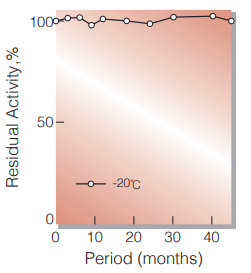
Fig.1. Stability (Powder form)
(kept under dry conditions)
-
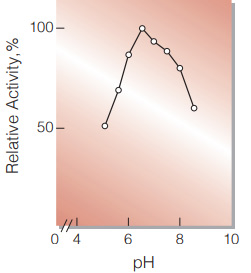
Fig.2. pH-Activity
(30 ℃ in 50 mM phosphate buffer)
-
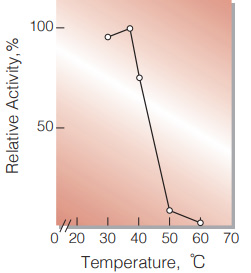
Fig.3. Temperature activity
(in 50 mM phosphate buffer, pH 7.0)
-
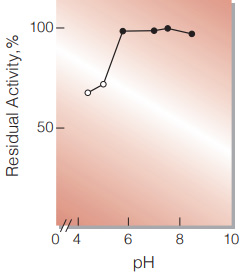
Fig.4. pH-Stability
30 ℃, 15 hr-treatment with buffer solution: pH 4.5-7.0, 50 mM acetate;pH 6.0-8.5, 0.1 M phosphate
-
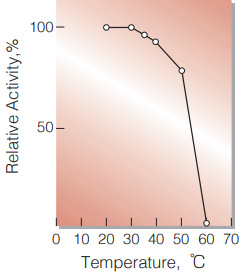
Fig.5. Thermal stability
10 min-treatment with 0.1 M phosphate buffer, pH 7.0 enzyme concn.:5 U/mL
活性測定法(Japanese)
1. 原理

p-Nitroanilineの生成量を410nmにおける吸光度の変化で測定する。
2.定義
下記条件で1分間に1マイクロモルのp-Nitroanilineを生成する酵素量を1単位(U)とする。
3.試薬
- 0.1M K-Phosphate緩衝液,pH7.0
- 5mM Z-Gly-Pro-pNA溶液〔21.3mgのZ-GlyPro-pNA(MW=426.43)を60℃の湯浴中で約 8 mLの40%ジオキサン蒸留水に溶解する。本溶解液を25℃まで冷却した後,40%ジオキサンで10 mLとする〕(用時調製)
- 10% トリトンX-100を含む1M酢酸緩衝液, pH4.0
- 酵素希釈液〔50mM K-Phosphate緩衝液, pH7.0〕
酵素溶液:酵素標品を予め氷冷した酵素希釈液(D) で溶解し,分析直前に同緩衝液で0.05〜 0.2U/mLに希釈する。
4.手順
1.試験管に下記反応混液を調製し,30℃で約5分間予備加温する。
| 1.0 mL | K-Phosphate緩衝液 | (A) |
| 0.25 mL | 基質溶液 | (B) |
2.酵素溶液0.1 mLを加え,反応を開始する。
3.30℃で正確に5分間反応させた後,酢酸緩衝液 (C)2.0㎖を加えて反応を停止させる。この液につき 410nmにおける吸光度を測定する(ODtest)。
4.盲検は反応混液①を30℃で5分間加温後,酢酸緩衝液(C)2.0㎖を加えて混和し,次いで酵素溶液0.1㎖を加えて調製する。この液につき以下上記同様に吸光度を測定する(ODblank)。
5.計算式
U/mL =
-
ΔOD (OD test−OD blank)×3.35(mL)×希釈倍率
5.57×1.0×5(分)×0.1
| = ΔOD×1.20×希釈倍率 | |
| U/mg | = U/mL×1/C |
| 5.57 | : p-Nitroanilineのミリモル分子吸光係数 (cm2/micromole) |
| 1.0 | : 光路長(cm) |
| C | : 溶解時の酵素濃度(c mg/mL) |
CONTACT
-
For inquiries and cosultations regarding our products, please contact us through this number.
- HEAD OFFICE+81-6-6348-3843
- Inquiry / Opinion
